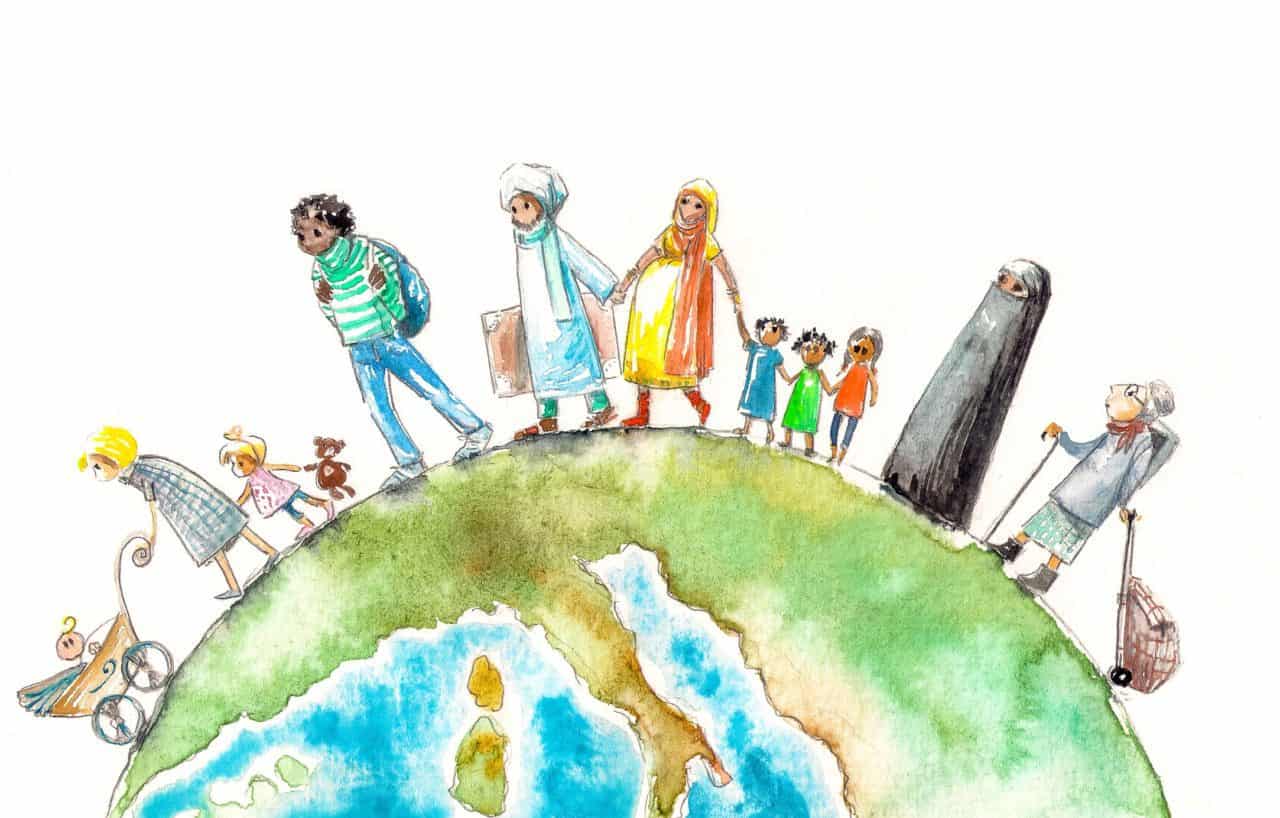Dec 16, 2021 | Alumni, Demography, Poverty & Equity, Women in Science, Young Scientists
By Fanni Daniella Szakal, 2021 IIASA Science Communication Fellow
Can we lift people out of energy poverty while simultaneously reducing carbon dioxide emissions? 2021 Young Scientists Summer Program (YSSP) participant Camille Belmin tried to tackle this seemingly contradictory issue by including fertility in the equation and estimating the conditions where an increase in energy access would reduce demand through decreasing population sizes.

© Photopassion77 | Dreamstime.com
About every third person in the world today doesn’t have access to clean cooking fuels and 1 in 10 are without electricity, predominantly in the Global South. Increasing energy access will not only improve the quality of life for many, but it will also propel us towards achieving some of the UN Sustainable Development Goals (SDGs) such as SDG3, Good Health and Wellbeing, and SDG7, Access to Clean and Affordable Energy.
The downside of increasing energy access is the surge in carbon dioxide emissions that will likely follow. Although populations with low energy access emit only a small share of global carbon emissions compared to countries in the Global North, an increase in energy provisioning would still put more pressure on the climate crisis. But, what if we could increase energy access and decrease emissions at the same time while tackling a few more SDGs in the process, such as SDG5, Gender Equality and SDG13, Climate Action?
Camille Belmin, a participant in the 2021 YSSP aimed to do just that. As a PhD Student at the Potsdam Institute for Climate Impact Research (PIK) and at the Humboldt University of Berlin, Belmin focuses on the relationship between energy access and women’s fertility. In a previous study covering 43 countries around the globe, she found evidence that higher access to electricity and modern cooking fuels was associated with women having fewer children.
“With more access to energy, instead of, for example, picking up firewood for many hours a day, women are able to spend more time on education and employment. Energy access also lowers the need for child labor and reduces child mortality through reduction of indoor air pollution and improved healthcare. This often leads to women becoming more empowered and gives them agency over their reproductive choices, leading to a fertility decline,” says Belmin.
In her YSSP project, Belmin took the energy-fertility relationship a step further: she wanted to explore if an initial boost in energy access could lead to a decline in energy demand in the long term through reduced population sizes, both increasing the quality of life and reducing carbon dioxide emissions.
“I hope that by showing that universal access to energy can also have benefits for sustainability, I can encourage investments in modern energy access in countries where basic services are lacking,” she notes.
To find out under which conditions increasing energy access will lead to a decrease in energy demand, Belmin used a microsimulation model of population projection. Under different energy access scenarios, the model follows each individual in a hypothetical population through life events, such as birth, death, and gaining access to education and electricity, while calculating their total energy consumption. She hoped to find a scenario with net savings in energy demand, in other words, a scenario where the more you give, the more you get.
Setting up the model was a new challenge for Belmin ̶ while many scientific fields have been using microsimulation for a long time, applying it to population modeling based on energy access is a novelty. The potential benefits and positive implications of the work were however well worth the difficulty.
The study focused on population simulations in Zambia, where Belmin collaborates with an NGO that aims to finance education for girls through carbon credits, building on the idea that education will lead to lower population sizes and decreased emissions in the future.
“Because of patriarchal structures, women are often bound to household chores, making the lack of energy a huge burden,” says Belmin. “This research is very important to me as a woman, or just as a human, as it seems that providing modern energy services might be a way for women to have more choice and freedom in their lives.”
Further information:
Belmin, C. (2021). Introducing the energy-fertility nexus in population projections: can universal access to modern energy lead to energy savings? IIASA YSSP Report. Laxenburg, Austria: IIASA [pure.iiasa.ac.at/17688]
Note: This article gives the views of the author, and not the position of the Nexus blog, nor of the International Institute for Applied Systems Analysis.
Nov 26, 2021 | Demography, Environment, Finland, IIASA Network, Poverty & Equity
By Venla Niva, DSc researcher with the Water and Development Research Group, School of Engineering, Aalto University, Finland
Venla Niva shares insights from a recent article exploring the interplay of environmental and social factors behind human migration. The project was carried out in collaboration with Raya Muttarak from the IIASA Population and Just Societies Program.

© Irina Nazarova | Dreamstime.com
Environmental migration has gained increasing attention in the past years, with recent climate reports and policy documents highlighting an increase in environmental refugees and migrants as one of the potential effects of the warming globe. Policymaking is dominated by a narrative that portrays environmental migration as a security threat to the “Global North”. Meanwhile, researchers around the world have put enormous efforts into understanding environmental migration and what is driving it. Yet, the causes and effects of environmental migration remain under debate.
In our latest paper, we extend the understanding of environmental migration by looking into how environmental and societal factors interacted in places of excess out- or in-migration between 1990 and 2000. We found that understanding these interactions is key for understanding migration drivers. Ultimately, migration is based on human decision-making, and in our view “simply cannot and should not be studied without the inclusion of the societal dimension: human capacity and agency.” Our findings were both expected and, to a certain degree, surprising.
Our results show that the majority of global migration takes place in areas with rather similar profiles. It is known that migration mostly occurs over short distances, and that internal migration – in other words, people moving around in their own country – outplays international migration – people moving between countries – by significant numbers globally. This, however, shows that the characteristics of these areas are alike too. High environmental stress coupled with low-to-moderate human capacity characterized these areas at both ends of migration. Such characteristics portray a combination of variables with a high degree of drought and water risks, natural hazards, and food insecurity, but low levels of income, education, health, and governance.
We found that income was the best variable to explain the variation of net-negative and net-positive migration in around half of the countries, globally, confirming that income is a good predictor of migration. This is interesting in two ways. According to traditional migration theories, income disparity between regions is seen as the primary driver for migration. Yet, income only dominated the other variables in half of the countries we examined. Education and health were especially important in areas with more out-migration than in-migration. Drought and water risks were important explaining factors in many countries, but were outranked by societal factors such as income, health, education, and governance in the majority of countries.
In light of our research, we would like to point out that it is unlikely that environmental factors alone would be responsible for migration. Instead, the role of human agency is vital. Investments in building human capacity have two-fold benefits: First, higher human capacity facilitates not only local adaptation to changes in the environment, but also adaptation at the destination in case of migrating. Second, protecting ecosystems and the environment helps to mitigate and adapt to climate and environmental change in areas with high environmental stress, which is again crucial for maintaining livelihoods and a good life at both ends of migration.
Environmental migration is often portrayed by the media as a catastrophic phenomenon. Our study confirms that migration drivers are a result of the interactions between socioeconomic and environmental factors and that human capacity plays a central role in both enabling the migration process and adaptation at the place of destination.
Further info:
Niva, V., Kallio, M., Muttarak, R., Taka, M., Varis, O., & Kummu, M. (2021). Global migration is driven by the complex interplay between environmental and social factors. Environmental Research Letters DOI: 10.1088/1748-9326/ac2e86. [pure.iiasa.ac.at/17507]
Note: This article gives the views of the author, and not the position of the Nexus blog, nor of the International Institute for Applied Systems Analysis.
Aug 19, 2020 | Climate Change, COVID19, USA, Wellbeing, Young Scientists
By Lisa Thalheimer, 2020 IIASA Young Scientists Summer Program (YSSP) participant in the Risk and Resilience and World Population Programs
Lisa Thalheimer shares her journey in researching climate-related migration in the age of the COVID-19 pandemic and the importance of taking mental health issues into account in climate science and the policy realm.

© Raul Mellado Ortiz | Dreamstime.com
COVID-19 has changed our idea of normal. These unprecedented, stressful times affect us all – some of us more than others. Fear and anxiety over a new disease without any promise of a vaccine anytime soon, global economic downturn, along with feelings of loneliness and emotional exhaustion due to the lockdown, can leave us mentally exhausted. Rates of depression and addiction-related suicide are in fact already on the rise among young people like myself.
Now imagine you are advised to stay at home, but you cannot do so because climate change has turned your entire life upside down: your house is no longer there, you have lost your job, your family or friends – you are likely to feel unhinged. This is a reality for many migrants across the globe. It is inevitable that existing migration patterns will be shifted beyond disasters alone. Cascading impacts form the still unfolding pandemic could compound. No matter if you are a migrant yourself or not, agency and the choice over the decision whether to leave your house or not, and the luxury to socially distance could potentially not be an option with a systemic shock like COVID-19.
These changes in circumstances have also affected me as a young scientist. I would have been in Laxenburg, getting to know my YSSP peers and IIASA colleagues, but this year’s journey has been rewritten – courtesy of the COVID-19 pandemic.
I was living in Oxford in the UK when I came to realise that mental health is a game changer in the way I manage my day, make decisions, my ability to care for my partner who suffers from Amyotrophic Lateral Sclerosis (ALS), and making progress on my PhD thesis. Everything felt more difficult. I was overwhelmed. I wanted to understand why this is the case. My interest soon evolved into researching the links between mental health and my PhD topic of climate-related migration.
For the article “The hidden burden of pandemics, climate change and migration on mental health”, I teamed up with an epidemiologist who specialises in mental health at my old university home, the Earth Institute in New York City. This research experience was an eye-opener, both personally and scientifically.
In our article, we focused on the US, as it has been hit hardest by COVID-19 – in mid-August, the number of COVID-19 cases exceeded five million. On top of this, depression and anxiety are already prominent among Americans, as is costly impacts from disasters. Hurricanes cost the US around US$ 17 billion every year, but estimates show a higher probability of extremely damaging hurricane seasons with climate change. We may know the impact of climate change on assets and on physical health, but what about mental health impacts?

© Raggedstonedesign | Dreamstime.com
Although my coauthor and I come from different scientific disciplines, I soon came to realize that our scientific approach has a common denominator: systems thinking. Accounting for interconnections and cascading effects, our article shed light on different systems affected by COVID-19 and situations where mental health issues are likely to become increasingly prevalent in a changing climate. The article focuses on already vulnerable parts of the population, for example those who have been impacted by Hurricane Katrina or Hurricane Harvey – the latter of which has been made worse by climate change. The article illustrates how COVID-19 becomes a risk multiplier for climate migrants in three distinct case studies: key workers in New York as urban setting, seasonal migration dynamics, and disproportionate effects on black and Latino communities. Unrelenting effects include loss of employment, and a lower likelihood of being able to work from home or to have health insurance than white people.
A better understanding of the mental health-migration-climate change nexus can help absorb adverse mental health outcomes from COVID-19, which would otherwise compound. We however need to tackle systemic risks affecting mental health through synergies in research and policy, and an integrated intervention approach. Free mental health support for key workers through tele-therapy and mental health hotlines provide a practical way forward. Personally, I learned that climate migrants have been relentlessly resilient to systemic shocks. Nevertheless, with mental health issues, it becomes increasingly hard to maintain such resilience. With this commentary, I hope that mental health and interdisciplinary research finds its way in climate science and in the policy realm. We all need a clear mind to attain the Sustainable Development Goals.
Note: This article gives the views of the author, and not the position of the Nexus blog, nor of the International Institute for Applied Systems Analysis.
Jun 5, 2020 | COVID19, Demography, Health, IIASA Network
By Tomas Sobotka, Wittgenstein Centre for Demography and Global Human Capital (Univ. Vienna, IIASA, VID/ÖAW), Vienna Institute of Demography
Does COVID-19 affect men and women differently? Tomas Sobotka sheds light on the demographics of the coronavirus pandemic in Europe.

© Florin Seitan | Dreamstime.com
A question from a Time magazine article has a clear underlying message: “Why is COVID-19 striking men harder than women?” By now, everyone has learned that men are more vulnerable to COVID-19 and, if infected, they tend to die much more often than women.
Are men however also more likely to get infected? On the face of it, the number of infections by gender suggests an almost perfect gender equality. Women represent on average 47% of all infections in 70 countries reporting the number of cases by sex, as listed in the online data tracker by Global Health 5050.
Case settled? Not quite yet. The aggregated total number might be deceiving. To understand an underlying story, one has to dig into the age and sex components of total infections. The overall balance of COVID cases by gender is an outcome of age- and sex-specific patterns of infection rates and the actual age- and sex composition of the population. This in turn, is often gender-unequal, especially at older ages, due to excess mortality among men and higher longevity of women.
In fact, in ten European countries I examined with colleagues from the Wittgenstein Centre for Demography and Global Human Capital, including Raya Muttarak from the IIASA World Population Program, it turns out that infection rates are highly gendered, especially when looking at the age pattern of coronavirus infection. From the teenage years up until their late 50s, women are more likely than men to be infected with COVID-19. Women in their 20s display the biggest gender gap in infections: on average only 64 men were infected per 100 infected women aged 20-29. After age 60, the pattern reverses, as infection rates among women drop at age 60-69 and the male infection rates go up or stay stable. This crossover is also clearly visible in the charts for Belgium, Czechia, Germany, and Italy. Between ages 60 and 79, men are more likely than women to be infected. The imbalance is sharpest among people in their 70s, with an average of 136 infected males per 100 infected women. This puts older males at a double disadvantage: they are more likely to be infected and, once infected, they are much more likely to die (with both higher age and being a male identified as important risk factors).
Is our evidence credible? Clearly, many infections are undetected and our data are affected by different testing availability and testing priorities across countries. It is possible that women of working age get more frequently tested than men as women tend to be more concerned about their health. This would bias the estimated share of infected women upwards. However, the remarkable regularity in the age- and gender-pattern of infections in the analyzed countries suggests that the observed gender disparities are real. The same gender disparity by age is observed in Czechia, Denmark, Germany, and Norway with relatively few infections, as well as in Belgium, England, Italy, and Spain with high numbers of reported infections. Of course, countries differ in their gender imbalance, especially at younger ages: the gender gap is, well, gaping, in Belgium, which reports only 34 infected men per 100 infected women at age 20-29. It is much smaller in Czechia, Germany, and Norway, but the female dominance at young ages and the male dominance at older ages, with a crossover around age 60, is consistently found in each society we studied.
What’s the likely explanation? At younger ages, the smoking gun points at women’s employment and occupations. Most women of working age in Europe are employed. This may also partly explain why European countries actually register a higher number of infections among women than most other countries, with an average share of 55%. More importantly, women are often working in professions that are most exposed to the infection. Think of nurses, medical doctors, other healthcare professionals, but also all the care workers in retirement homes, which turned out in some countries to be the focal points of infection. The switch in gender balance occurs right around the retirement age. The higher likelihood of infection among older men is probably linked with their poorer health and lower immunity.
If employment is potentially risky for women, staying at home with children—itself a product of ingrained gender inequalities in work and care—may lead to fewer infections. In countries where women’s employment dips after age 30 due to their extensive parental leaves, infection rates often show a distinct dip after that age as well, going up again in their 40s: Czechia, Germany, and partly Norway and Switzerland show such an M-shaped pattern of infection rates among women.
Even though the fatality rates of women below age 60 are low, engagement in care-work poses a higher risk to healthcare workers and care-home staff. This factor should be included in the ongoing discussions on the impact of COVID-19 on women’s health and wellbeing.

COVID-19 infection rates by age and sex per 1,000 population (solid line for females, dashed line for males, left-hand axis) and the relative M/F ratio in infection rates by age in four European countries
This blogpost is based on the following paper:
Sobotka T, Brzozowska Z, Muttarak R, Zeman K, & di Lego V (2020). Age, gender and COVID-19 infections. medRxiv 2020.05.24.20111765. DOI: https://doi.org/10.1101/2020.05.24.20111765
References
Global Health 5050. COVID-19 sex-disaggregated data tracker. https://globalhealth5050.org/covid19/ (accessed May 18, 2020)
Ducharme J. Why Is COVID-19 Striking Men Harder Than Women? Time, 1 May 2020. https://time.com/5829202/covid-19-gender-differences/
Note: This article gives the views of the author, and not the position of the Nexus blog, nor of the International Institute for Applied Systems Analysis.
Apr 8, 2020 | Brazil, COVID19, Health, Women in Science
By Raquel Guimaraes, postdoc in the IIASA World Population Program
IIASA postdoc Raquel Guimaraes writes about efforts by the scientific community to encourage governments in Latin America and the Caribbean to increase COVID-19 test coverage to reduce vulnerability.

© Kukhunthod | Dreamstime.com
Together with a group of demographers from Latin America and the Caribbean (LAC), and endorsed by more than 250 individuals from the academic community, I contributed to a statement urging governments, the World Health Organization, and the Pan American Health Organization, to take immediate action to drastically increase the coverage of COVID-19 tests in the region. This call for action was disseminated by the British Society for Population Studies, Asociación Latino Americana de Población, Sociedad Mexicana de Demografía, Associação Brasileira de Estudos Populacionais, and the Population Association of America, among other important institutions.
I joined this initiative by invitation from Dr. Enrique Acosta and other colleagues, because I firmly believe that the prospects for the COVID-19 pandemic in the LAC region are rather dramatic. Several studies document that, apart from being globally recognized for its high levels of economic and social inequality, the region also suffers from institutional coordination failures and poor governance, a lack of appropriate resources, and presents a unique epidemiological and demographic profile of its population that escalates the negative prospects of the pandemic. I wanted to explore in more detail why these features of LAC are a source of major concern and require immediate action.
Social and economic inequality in LAC will hamper the enforcement of social distancing and isolation measures, which have proven to mitigate the COVID-19 epidemic in other settings. More than half of the population is in the informal labour market and does not have access to social safety nets. For those covered by the social security system, the benefits already proposed by a few governments of the region such as Brazil, fall short of the daily needs of families. In addition to economic inequality, social inequality, which leads to a high degree of cohabitation between adults and the elderly, increases the exposure of those with the highest risk of complications and death.
In addition, with the closure of schools, children who do not have access to day-care centres and the public- or private education system, often rely on the help of their grandparents, which again brings greater vulnerability to families. Not to mention that these children won’t have ensured their learning opportunities, because their parents are often working and not able to home-school them, thus compromising their education outcomes.
Moreover, LAC is facing a rapid demographic transition and aging process, which is temporarily increasing the prevalence of a young population, meaning that the population age-structure of potential infected individuals differs from that of other settings. However, unlike the more developed countries, LAC’s epidemiologic transition, that is, the transition in which the prevalence of infectious diseases is “substituted” by chronic and degenerative diseases, is not complete. Paradoxically, the region exhibits both the prevalence of diseases that have long been eradicated in more developed contexts (such as malaria, dengue, and tuberculosis) and diseases of richer countries (such as hypertension, diabetes, and neoplasms).
On top of all the above-mentioned vulnerabilities, crisis-management efforts in the region are uncoordinated, and lacking transparency and commitment. Taking Brazil as an example: while some mayors and governors adopt measures of social isolation and prevention against COVID-19, parts of the federal executive power not only disdain the problem, but encourages the population not to meet the requirements established by the Ministry of Health. Such conflicting rules are bound to cause misunderstandings among the LAC population. The COVID-19 pandemic is a crucial moment for institutional coordination to ensure the effective management of the crisis.
As an important and urgent call to action for the pandemic in the region, myself and other LAC researchers are calling for an increase in test coverage and measures of social isolation. As reported in the non-specialized media under the slogan “help to flatten the curve”, social isolation allows the rate of contagion of the virus to be reduced, in order to prevent overloading the capacity of the health system. Existing literature documents that while the virus does not cause major damage to health for the majority of infected persons, it brings a high cost to the health system. Furthermore, the impacts on the later lives of individuals who were hospitalized due to the disease are not yet known. Not to mention, of course, the human tragedy and the costs in terms of lives lost to the disease.
Finally, imperative and immediate action against COVID-19 in LAC will depend on the widespread and low-cost application of tests. This is required because the former rigorous isolation measures mentioned above are highly ineffective if not accompanied by aggressive strategies to detect cases of COVID-19. This highlights the relevance of data collection to better inform policymakers and provide researchers with clear diagnoses of the conditions in the region.
References:
Deaton A (2013). Cap. 3. Escaping death in the Tropics. In The Great Escape: Health, Wealth, and the Origins of Inequality. Princeton University Press.
Hoffman K, & Centeno MA (2003). The Lopsided Continent: Inequality in Latin America. Annual Review of Sociology, 29(1), 363–390. https://doi.org/10.1146/annurev.soc.29.010202.100141
Khemani S, Ferraz C, Finan FS, Johnson S, Louise C, Abrahams SD, Odugbemi AM, Dal Bó E, & Thapa D (2016). Making politics work for development: Harnessing transparency and citizen engagement (Policy Research Report). The World Bank. http://documents.worldbank.org/curated/en/268021467831470443/Making-politics-work-for-development-harnessing-transparency-and-citizen-engagement
Pérez CC, & Hernández AL (2007). Latin–American public financial reporting: Recent and future development. Public Administration and Development, 27(2), 139–157. https://doi.org/10.1002/pad.441
Note: This article gives the views of the author, and not the position of the Nexus blog, nor of the International Institute for Applied Systems Analysis








You must be logged in to post a comment.